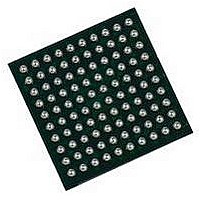EP3C10M164C8N Altera, EP3C10M164C8N Datasheet - Page 202

EP3C10M164C8N
Manufacturer Part Number
EP3C10M164C8N
Description
IC CYCLONE III FPGA 402MHZ BGA-164
Manufacturer
Altera
Series
Cyclone IIIr
Specifications of EP3C10M164C8N
No. Of Logic Blocks
645
Family Type
Cyclone III
No. Of I/o's
106
I/o Supply Voltage
3.3V
Operating Frequency Max
402MHz
Operating Temperature Range
0°C To +85°C
Family Name
Cyclone III
Number Of Logic Blocks/elements
10320
# I/os (max)
106
Frequency (max)
402MHz
Process Technology
65nm
Operating Supply Voltage (typ)
1.2V
Logic Cells
10320
Ram Bits
423936
Operating Supply Voltage (min)
1.15V
Operating Supply Voltage (max)
1.25V
Operating Temp Range
0C to 85C
Operating Temperature Classification
Commercial
Mounting
Surface Mount
Pin Count
164
Package Type
MBGA
Lead Free Status / RoHS Status
Lead free / RoHS Compliant
Lead Free Status / RoHS Status
Lead free / RoHS Compliant
Available stocks
Company
Part Number
Manufacturer
Quantity
Price
- Current page: 202 of 350
- Download datasheet (8Mb)
9–42
Cyclone III Device Handbook, Volume 1
Figure 9–19
MasterBlaster, USB-Blaster, ByteBlaster II, or ByteBlasterMV cable.
Figure 9–19. Multi-Device PS Configuration Using a USB-Blaster, MasterBlaster, ByteBlaster II,
ByteBlasterMV, or Ethernet Blaster Cable
Notes to
(1) The pull-up resistor must be connected to the same supply voltage as the V
(2) You only need the pull-up resistors on DATA[0] and DCLK if the download cable is the only configuration scheme
(3) Pin 6 of the header is a V
(4) Connect the pull-up resistor to the V
(5) The nCEO pin of the last device in the chain is left unconnected or used as a user I/O pin.
(6) The MSEL pin settings vary for different configuration voltage standards and POR time. To connect MSEL[3..0]
(7) Power up the V
10
used on your board. This is to ensure that DATA[0] and DCLK are not left floating after configuration. For example,
if you are also using a configuration device, you do not need the pull-up resistors on DATA[0] and DCLK.
device. For this value, refer to the
this pin is a no connect. In USB-Blaster, ByteBlaster II, and Ethernet Blaster, this pin is connected to nCE when it is
used for AS programming. Otherwise, it is a no connect.
for PS configuration schemes, refer to
Third-party programmers must switch to 2.5 V. Pin 4 of the header is a V
The MasterBlaster cable can receive power from either 5.0- or 3.3-V circuit boards, DC power supply, or 5.0 V from
the USB cable. For this value, refer to the
kΩ
V
CCA
Figure
10
Chapter 9: Configuration, Design Security, and Remote System Upgrades in the Cyclone III Device Family
(2)
kΩ
V CCA (1)
(1)
shows PS configuration for multi Cyclone III device family using a
9–19:
V CCIO (4)
CC
of the ByteBlaster II, USB-Blaster, or ByteBlasterMV cable with a 2.5- V supply from V
10
GND
kΩ
IO
Cyclone III Device Family 2
Cyclone III Device Family 1
reference voltage for the MasterBlaster output driver. V
nCONFIG
DATA[0]
MSEL[3..0] (6)
nCE
nCE
MSEL[3..0]
(6)
nCONFIG
DATA[0]
MasterBlaster Serial/USB Communications Cable User
CCIO
CONF_DONE
CONF_DONE
Table 9–7 on page
nSTATUS
supply voltage of the I/O bank in which the nCE pin resides.
nSTATUS
MasterBlaster Serial/USB Communications Cable User
DCLK
DCLK
nCEO
nCEO
10
N.C. (5)
kΩ
V CCA (1)
9–11. Connect the MSEL pins directly to V
V CCA (1)
10
10
(2)
kΩ
kΩ
V CCA (1)
CC
power supply for the MasterBlaster cable.
CCA
© December 2009 Altera Corporation
supply.
IO
must match the V
10-Pin Male Header
(Passive Serial Mode)
Pin 1
Guide. In ByteBlasterMV,
Download Cable
Configuration Features
GND
Guide.
V CCA (7)
CCA
CCA
VIO (3)
GND
CCA
or GND.
of the
.
Related parts for EP3C10M164C8N
Image
Part Number
Description
Manufacturer
Datasheet
Request
R

Part Number:
Description:
CYCLONE II STARTER KIT EP2C20N
Manufacturer:
Altera
Datasheet:

Part Number:
Description:
CPLD, EP610 Family, ECMOS Process, 300 Gates, 16 Macro Cells, 16 Reg., 16 User I/Os, 5V Supply, 35 Speed Grade, 24DIP
Manufacturer:
Altera Corporation
Datasheet:

Part Number:
Description:
CPLD, EP610 Family, ECMOS Process, 300 Gates, 16 Macro Cells, 16 Reg., 16 User I/Os, 5V Supply, 15 Speed Grade, 24DIP
Manufacturer:
Altera Corporation
Datasheet:

Part Number:
Description:
Manufacturer:
Altera Corporation
Datasheet:

Part Number:
Description:
CPLD, EP610 Family, ECMOS Process, 300 Gates, 16 Macro Cells, 16 Reg., 16 User I/Os, 5V Supply, 30 Speed Grade, 24DIP
Manufacturer:
Altera Corporation
Datasheet:

Part Number:
Description:
High-performance, low-power erasable programmable logic devices with 8 macrocells, 10ns
Manufacturer:
Altera Corporation
Datasheet:

Part Number:
Description:
High-performance, low-power erasable programmable logic devices with 8 macrocells, 7ns
Manufacturer:
Altera Corporation
Datasheet:

Part Number:
Description:
Classic EPLD
Manufacturer:
Altera Corporation
Datasheet:

Part Number:
Description:
High-performance, low-power erasable programmable logic devices with 8 macrocells, 10ns
Manufacturer:
Altera Corporation
Datasheet:

Part Number:
Description:
Manufacturer:
Altera Corporation
Datasheet:

Part Number:
Description:
Manufacturer:
Altera Corporation
Datasheet:

Part Number:
Description:
Manufacturer:
Altera Corporation
Datasheet:

Part Number:
Description:
CPLD, EP610 Family, ECMOS Process, 300 Gates, 16 Macro Cells, 16 Reg., 16 User I/Os, 5V Supply, 25 Speed Grade, 24DIP
Manufacturer:
Altera Corporation
Datasheet:












